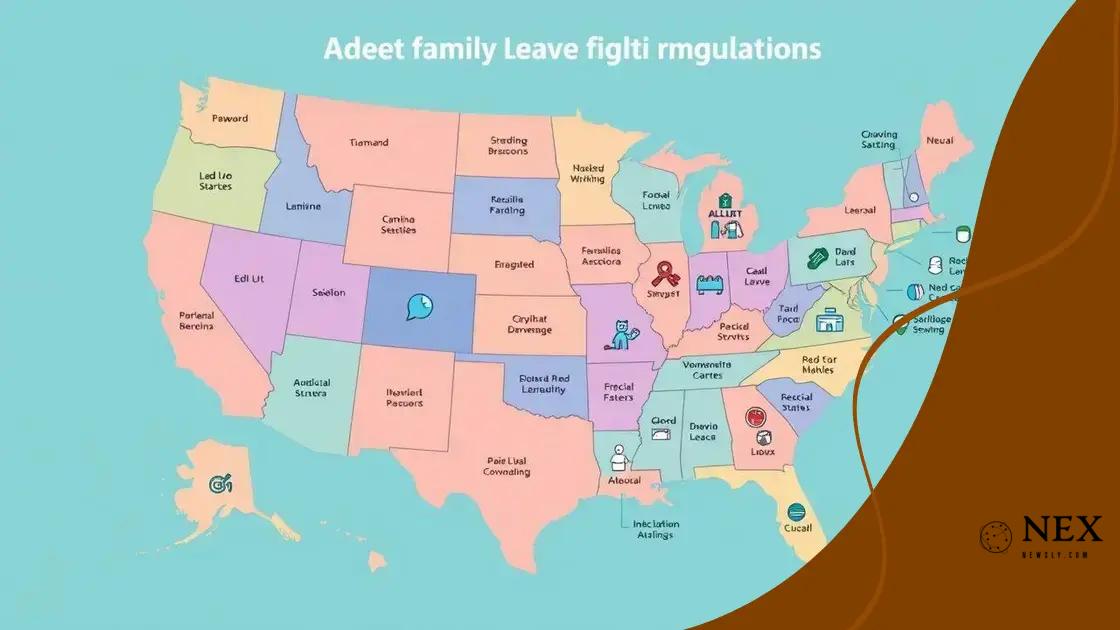Paid family leave policies broadened: understanding the changes

Anúncios
Paid family leave policies provide income and job protection for employees taking time off to care for family members, enhancing health and well-being for families and promoting workplace satisfaction.
Paid family leave policies broadened are reshaping how families manage time off during critical moments. Have you thought about how this affects your life or someone you know? Let’s dive into these changes and what they mean for families today.
Anúncios
The evolution of family leave policies
The evolution of family leave policies has significantly shaped how families care for their loved ones over the years. From the traditional approaches to more progressive measures, understanding this evolution can help us appreciate how far we’ve come.
In the late 20th century, most family leave options were limited and often unpaid. However, societal changes prompted a re-evaluation of these policies. As more women entered the workforce, the need for supportive family leave options became evident.
Key Developments in Family Leave
Throughout the years, various key developments have paved the way for better family leave policies. Below are some significant milestones:
Anúncios
- The introduction of the Family and Medical Leave Act (FMLA) in 1993 marked a new beginning for family leave in the United States.
- Over time, several states implemented their own paid family leave programs, showcasing different approaches.
- Public awareness and advocacy for family-friendly policies have led to increased pressure on employers to adopt better leave practices.
As we moved into the 21st century, companies began recognizing the importance of work-life balance. This shift resulted in more organizations offering paid leave as an employee benefit. Trends indicate that businesses with robust family leave policies enjoy higher employee satisfaction and retention.
Current Trends
Today, paid family leave is not just a perk but a necessity for many. The current trends emphasize inclusiveness and equity. Some policies now cover adoption and other family structures, acknowledging a diverse range of family needs.
Some states have undergone substantial changes to their policies, making them more accessible and comprehensive. For example, states like California and New Jersey have expanded their paid leave benefits, allowing families to take the time they need without financial stress. This is crucial as it contributes to healthier family dynamics and well-being.
Looking at the advancements made so far, it’s clear that we are moving toward a more inclusive future in family leave. Awareness and advocacy continue to play a key role in shaping policies that support families in various situations.
Key benefits of expanded paid family leave
Understanding the key benefits of expanded paid family leave is vital for families and employers alike. These benefits can lead to improved family dynamics, enhanced employee satisfaction, and better overall community health.
One of the main advantages of expanded paid family leave is financial stability. When parents can take time off without losing income, they are better able to care for their newborns or ill family members. This helps ease the stress associated with balancing work and family obligations.
Improved Health Outcomes
Research shows that when families have access to paid family leave, health outcomes improve. Parents can spend more time with their children, promoting bonding and reducing the risks of developmental issues. Additionally, children are less likely to experience healthcare access issues.
- Children thrive with parental support during critical growth periods.
- Parents can manage mental health better during stressful life changes.
- Healthier family environments promote long-term wellness.
Another benefit includes greater workplace retention. Companies that offer paid family leave often see reduced turnover rates. Employees are more likely to stay with an employer that treats them well during significant life events. This leads to lower hiring costs and a more experienced workforce.
Additionally, employee morale tends to increase with supportive leave policies. When employees know they can take time off for family without penalties, they feel valued and engaged, which boosts overall productivity.
Boosting Workplace Productivity
Finally, expanded paid family leave can promote workplace productivity. Employees returning from a leave feel refreshed and focused, ready to contribute positively to their roles. Organizations with happy employees often outperform their competitors.
In summary, the benefits of paid family leave create a win-win scenario for families and businesses. As these policies continue to expand, the positive effects will likely resonate across communities, shaping healthier and more resilient families.
How different states approach family leave

Different states across the United States have varied approaches to family leave, reflecting local values and priorities. Understanding these differences can shed light on how family leave policies impact residents.
Some states have enacted comprehensive paid family leave laws, while others depend on federal regulations, creating a patchwork system. This diversity affects which workers have access to paid leave and under what circumstances.
Leading States in Family Leave Policies
States like California, Washington, and New Jersey are leading the way with robust family leave programs. These policies often provide paid leave for new parents and caregivers, promoting healthier family dynamics.
- California offers up to 8 weeks of paid leave at a percentage of your earnings.
- Washington provides a paid family leave program funded through employee contributions.
- New Jersey has one of the most comprehensive leave laws, allowing families to take time off for a range of situations.
These states have demonstrated that expanded paid family leave can increase workforce retention and employee satisfaction. Workers feel secure knowing they can take necessary time off without financial hardship.
Challenges in Other States
However, not all states have adopted similar measures. Many rely solely on the Family and Medical Leave Act (FMLA), which does not guarantee paid leave. This limits access for many individuals who cannot afford to take unpaid time off.
In states with fewer protections, employees often face significant pressure to choose between their job and family responsibilities. For some, the lack of paid leave can result in health issues or strained family relationships.
As we can see, the approach to family leave varies significantly across the country. The disparities not only affect individual families but also have broader implications for workplace culture and community welfare.
Challenges faced by families under these policies
Families face several challenges under paid family leave policies, which can vary depending on where they live. While many policies aim to help, the implementation and accessibility often create hurdles for those in need.
One significant challenge is the inconsistency in coverage. Not all states offer paid family leave, and even where it exists, benefits vary widely. Families may find themselves dealing with complicated paperwork or understanding eligibility requirements, which can lead to confusion.
Financial Strain During Leave
Another obstacle is the potential financial strain that comes when parents take leave. In some cases, paid leave may not cover full salaries, making it challenging for families to make ends meet. This reduction in income can cause stress and anxiety during an already difficult time.
- Some families may need to budget tightly to afford everyday expenses.
- Healthcare costs can add additional financial pressure.
- Uncertainty about job security can make the situation worse.
Stigma associated with taking leave can also hinder families from utilizing these policies. Many workers fear they might be judged or face consequences at work for taking time off. This fear can prevent parents from accessing the benefits they are entitled to, leading to poor mental health and family relationships.
Access and Awareness Issues
Access to information presents another challenge. Many families are unaware of their rights surrounding paid family leave. Lack of outreach from employers or government agencies means that eligible participants might not know how to apply or what benefits they could receive.
Gaps in the understanding of these policies can also lead to underutilization. Families might assume they do not qualify for leave or may be misinformed about their options. This lack of awareness denies them crucial support in times of need.
In summary, while paid family leave policies aim to support families, numerous challenges impede their effectiveness. Understanding these issues is essential in advocating for better policies that can truly help families during significant life events.
Future trends in paid family leave
The landscape of paid family leave is continuously evolving, with new trends shaping how these policies are viewed and implemented. As society changes, so too does the understanding of what families need during significant life events.
One major trend is the increasing push for universal paid family leave. Advocacy groups are calling for policies that would provide a standardized level of paid leave for all workers across the country. This movement aims to simplify access and eliminate disparities among different states and employment sectors.
Inclusivity and Diversity in Family Leave Policies
Another emerging trend focuses on inclusivity within paid family leave. There is a growing recognition that family structures are diverse. Policies are beginning to reflect this by offering coverage for various family situations, including adoption, foster care, and care for elderly relatives.
- Legislation is being introduced to include non-biological family members.
- Paid leave policies are adapting to support LGBTQ+ families.
- More businesses are allowing flexible leave options to accommodate individual needs.
As companies recognize the importance of supporting their workers, many are adopting more flexible leave policies. This includes options for part-time leave or staggered returns to work. Such flexibility allows families to navigate their specific situations better and reduces stress during transitions.
Integration of Technology
Technology is also playing a significant role in shaping the future of paid family leave. Companies are utilizing platforms that streamline the application processes and provide resources for employees. These tools can help workers understand their entitlements and simplify the paperwork involved.
As we look ahead, there is a strong likelihood of ongoing advancements in employee engagement surrounding paid leave. Organizations prioritizing transparent communication about leave policies will likely see better adoption rates and employee satisfaction. Moreover, with increased attention to mental health, companies that embrace supportive leave policies may create healthier workplace environments.
In conclusion, the future trends in paid family leave are leaning towards inclusivity, flexibility, and technology integration. These changes promise to enhance the way families experience important moments together, ultimately improving the quality of life for many.
FAQ – Frequently Asked Questions about Paid Family Leave
What is paid family leave?
Paid family leave allows employees to take time off work to care for their family without losing income.
How long can I take paid family leave?
The duration varies by state or company policy, but it typically ranges from a few weeks to several months.
Who is eligible for paid family leave?
Eligibility depends on state laws or company policies, but it generally includes new parents and caregivers for sick relatives.
What are the benefits of paid family leave?
Benefits include improved family health, reduced financial stress, and increased employee satisfaction and retention.





